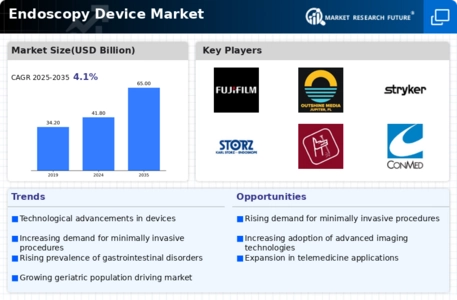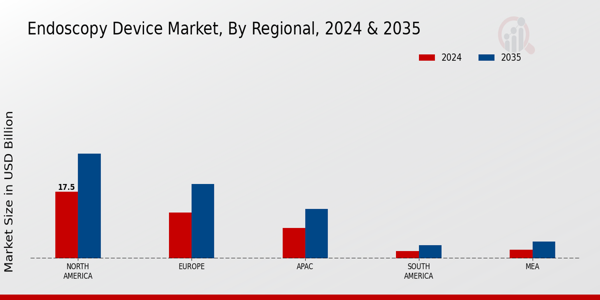Endoscopy Devices Size
Endoscopy Devices Market Growth Projections and Opportunities
Advancements in endoscopic technology, including high-definition imaging, flexible endoscopes, and advanced accessories, drive market growth by improving visualization, diagnostic accuracy, and therapeutic capabilities during endoscopic procedures, thus enhancing patient outcomes and driving demand for endoscopy devices. The increasing prevalence of gastrointestinal disorders such as colorectal cancer, gastrointestinal bleeding, and inflammatory bowel disease contributes to the growing demand for endoscopic procedures for diagnosis, treatment, and surveillance, fueling market expansion. With the aging population, there is a higher incidence of age-related gastrointestinal conditions such as colon polyps, esophageal strictures, and gastric ulcers, leading to an increased demand for endoscopic procedures for screening, diagnosis, and management among elderly individuals, thus influencing market growth. The shift towards minimally invasive surgical techniques drives market growth by increasing demand for endoscopy devices used in minimally invasive procedures such as laparoscopy, arthroscopy, and bronchoscopy. Minimally invasive approaches offer benefits such as reduced patient discomfort, shorter recovery times, and improved cosmetic outcomes, driving adoption of endoscopic devices.
Increasing adoption of screening programs for gastrointestinal cancers, such as colonoscopy for colorectal cancer screening, drives market growth by increasing demand for endoscopic devices used in screening, surveillance, and early detection of gastrointestinal conditions, thus facilitating timely intervention and improving patient outcomes. Integration of artificial intelligence (AI) and machine learning algorithms into endoscopic devices enhances diagnostic accuracy, lesion detection, and image analysis, driving market growth by improving procedural efficiency, reducing healthcare costs, and enhancing clinical decision-making in endoscopic practice. Stringent regulations govern the design, manufacturing, and marketing of endoscopy devices to ensure safety, efficacy, and quality standards. Compliance with regulatory requirements influences market dynamics and consumer confidence in available devices, thus shaping market trends and product offerings.
Reimbursement policies and coverage for endoscopic procedures by government healthcare programs and private insurance companies impact patient access to endoscopy services and device utilization. Reimbursement decisions influence market demand for endoscopy devices and drive adoption of new technologies and procedures. Patient preferences for less invasive diagnostic and therapeutic procedures drive market growth by increasing demand for endoscopy devices used in minimally invasive approaches. Patients prefer procedures that offer reduced discomfort, faster recovery times, and improved cosmetic outcomes, thus influencing market trends and device adoption rates. Rising healthcare expenditure globally contributes to market growth by increasing investment in healthcare infrastructure, medical technologies, and endoscopy services. Increased healthcare spending leads to greater adoption of endoscopic procedures and devices, driving market expansion and revenue growth.
The expansion of healthcare infrastructure and increasing access to medical services in emerging markets present growth opportunities for the endoscopy device market. Penetrating emerging markets drives market expansion and increases market share for manufacturers offering endoscopy devices. Ongoing research into endoscopic techniques, device innovations, and therapeutic applications drives innovation and product development within the market. Investments in research lead to the introduction of new endoscopy devices, accessories, and technologies, shaping market trends and driving adoption of advanced endoscopic procedures. Educational initiatives and training programs aimed at healthcare professionals drive market growth by increasing proficiency in endoscopic techniques, device usage, and procedural skills. Continuous medical education (CME) programs and hands-on training courses influence market dynamics by promoting best practices and improving patient outcomes.
Collaboration between gastroenterologists, surgeons, nurses, and medical device companies fosters interdisciplinary approaches to endoscopic practice and patient care. Multidisciplinary care teams influence market dynamics by promoting device utilization, knowledge sharing, and innovation in endoscopic procedures. Patient education and awareness campaigns about the importance of endoscopic screening, early detection, and preventive care drive market growth by increasing patient engagement and demand for endoscopic procedures. Empowering patients to understand the benefits of endoscopy for diagnosis and treatment of gastrointestinal conditions influences market dynamics and device utilization.
















Leave a Comment